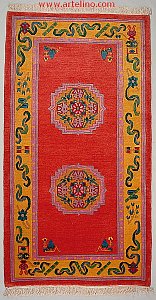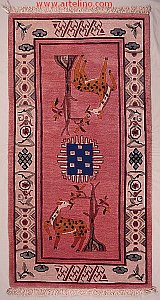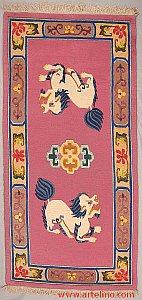| < Prev | Next > |
|---|
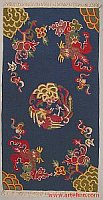 Tibetan carpets are unique works of art that date back to hundreds of years of tradition and history. The craftsmanship and production techniques of this traditional art are unique.
Tibetan carpets are unique works of art that date back to hundreds of years of tradition and history. The craftsmanship and production techniques of this traditional art are unique.
Traditional Tibetan carpets, including those produced today, are of high quality in terms of materials used in production, as well as in terms of the language of symbols that are embedded in rich colors with great artistic care. Since Tibet has fallen under Chinese control the tradition of Tibetan carpet making is carried on by the so-called Tibetan-Nepalese in exile.
Long Tradition of Tibetan Carpet Making
It is nearly impossible to identify the origins of this craft in Tibet. The manufacture and processing of wool in Tibet, however, can be traced back to the 4th century B.C. Tibetan carpets have various traditional uses that are rooted from the traditional lifestyles of nomadic tribes.
The nomadic tribes of Tibet trek at the higher altitudes through the cold and rocky mountainous regions of the Himalayas with their horses. They therefore need carpets on which to sleep, warm blankets, saddles for the horses, and covers for the ground in their tents, etc. The Tibetan carpet is still used today as a bedding layer, seat cushion and saddle cover.
But they are now also hung on walls in wealthier homes as decorations. The nomads lived in an isolated area and relied on their own skills and ingenuity, from which emerged the uniquely Tibetan carpet making techniques that have been refined over centuries. Today, Tibetan carpets are sold worldwide and highly valued.
Tibetan Carpets until the late 19th Century
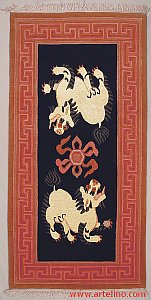 Until the late nineteenth century Tibetan carpets were made mostly from regional raw materials and resources, from dyes to wool. Beginning in the late nineteenth century some material was imported from India like cotton (for theft and warp) or synthetic colors.
Until the late nineteenth century Tibetan carpets were made mostly from regional raw materials and resources, from dyes to wool. Beginning in the late nineteenth century some material was imported from India like cotton (for theft and warp) or synthetic colors.
The highly elastic wool of the highland sheep has long threads and a sturdy fibrous structure. It also contains uncommonly more lanolin or wool fat and natural wool wax that, using gentle processing methods, remains preserved in the material.
Everything about the traditional Tibetan carpet is handmade, including the weaving of the wool. Traditionally, pigments used to dye the wool were extracted from regional vegetation. The natural pigments were first boiled in copper bowls and then applied to the wool.
Although vegetation in the highlands was not lush, the carpet weavers achieved many different nuances of blues, reds, pinks, oranges, yellows, browns and greens. Whites grays and blacks are natural colors of wool. It was not until the end of the 19th century that aniline colors began to spread gradually reaching Tibet via India.
Unique Weaving Techniques
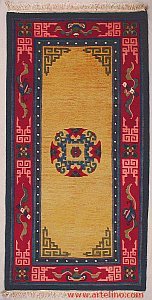 In contrast to other central Asian weaving techniques, traditional Tibetan carpets are made using vertical weaving looms. The threads used in the cross-pattern that makes up the base layer of the carpet are of high quality multi-threaded cotton yarn.
In contrast to other central Asian weaving techniques, traditional Tibetan carpets are made using vertical weaving looms. The threads used in the cross-pattern that makes up the base layer of the carpet are of high quality multi-threaded cotton yarn.
These threads are also typically doubled making the base layer thicker and ensuring its fastness and durability. In the carpets there are usually 7 to 10 knots per square centimeter, which normally yields a tuft strength of 1 to 1.5 cm - or a weight of 4-6 kg per square meter.
Tibetan carpet weavers also use rods like large needles to guide rows of threaded nooses through the vertical loom. Because rods are not used in other carpet making processes, the texture of a traditional Tibetan carpet is unique. When a row is completely through, the individual nooses are cut.
In newer production processes, they may not be cut in order to create special color effects. Tibetan carpet makers also often pass double knots through the tufts, giving the carpets unusual thickness and elasticity. Shorter threads can be used to create color contours or outlines.
Traditional Motifs
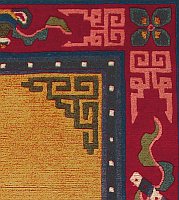 With few exceptions, the area of a Tibetan carpet is split into different zones: borders, corners, central image area and medallions. The individual motifs have favorite or preferred spots on the carpet - but is not always the case.
With few exceptions, the area of a Tibetan carpet is split into different zones: borders, corners, central image area and medallions. The individual motifs have favorite or preferred spots on the carpet - but is not always the case.
So animals as well as figurative representations appear in a "scene," or are stylized by floral rug designs. All elements found on Tibetan carpets belong to the symbolic tradition of Tibet, on the one hand with all other arts in connection, on the other hand religious and part of the culture of Tibet.
The key to understanding the visual elements is Buddhist religion, which is important not only in Tibet but China, India, and Mongolia as well. Floral patterns consist of the eight auspicious symbols, the 8 Chinese symbols of longevity - as well as the four symbols for skills in knowledge, discipline and success.
The six signs of a long life are: old man, a crane, pines, rocks, waterfall and the unicorn (later deer). Alongside these are symbol-laden flowers and fruits as well as various natural elements like clouds, mountains, oceans and fire.
These Tibetan carpet symbols are usually stylized or abstracted in patterns. There are however also other representations sometimes scenes with animals or mythic scenes. Often there are also dragons, cranes, field mice or bees. All these however have symbolic contexts.
Tibetan Carpets Today
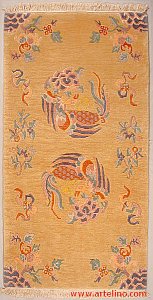 After the Chinese seizure of Tibet in 1959, the production of traditional Tibetan carpets was disrupted. But it was not lost and by 1965 Tibetan carpets began to appear again, but outside of Tibet in Nepal. Today, the Tibetan-Nepalese weave carpets in exile no longer for traditional uses like horse saddles but rather for export.
After the Chinese seizure of Tibet in 1959, the production of traditional Tibetan carpets was disrupted. But it was not lost and by 1965 Tibetan carpets began to appear again, but outside of Tibet in Nepal. Today, the Tibetan-Nepalese weave carpets in exile no longer for traditional uses like horse saddles but rather for export.
Over the last years there are some attempts to revitalize carpet production also in Chinese occupied Tibet. Center of these activities is the city of Gangtse. However the volume of carpet production is only a small fraction compared to Nepal.
More Traditional Tibetan Carpets
You find many more traditional Tibetan rugs in our Tibet rug shop.
Dieter Wanczura




